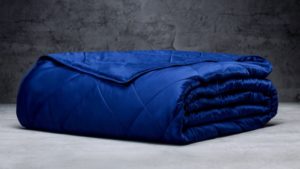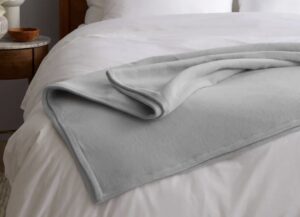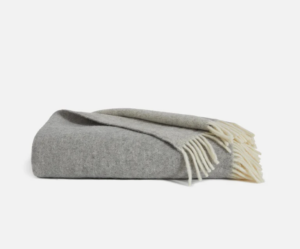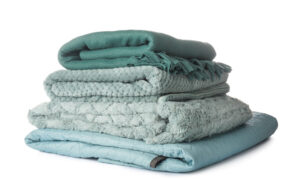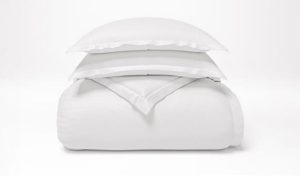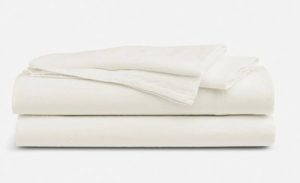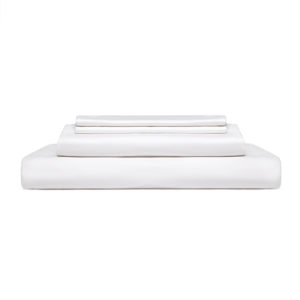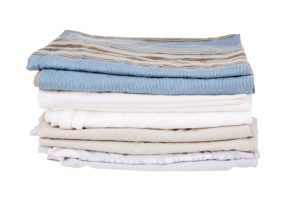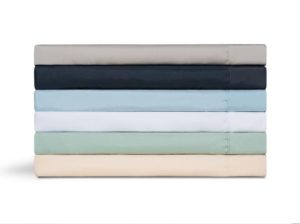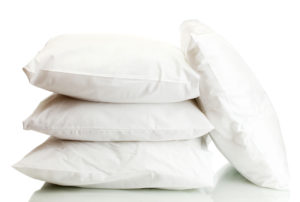How to Wash a Down Comforter
To wash a down comforter, use a large-capacity, front-loading washer with cold or warm water and a gentle detergent. Run it on a delicate wash cycle, then dry on low heat with wool dryer balls or clean tennis balls to help fluff the down. Make sure the comforter is completely dry before using or storing it to prevent mildew.
Down comforters are beloved for their cozy, insulating feel and high-quality materials, but when it comes to cleaning them, things can get a little tricky. If you use a duvet cover or top sheet, you may only need to wash your comforter once or twice a year. Still, knowing how to do it correctly can help extend its life and keep it feeling fresh.
Preparing to Wash a Down Comforter
Proper preparation can help simplify the process of cleaning a down comforter. While down is a durable material, it’s still important to use the right kind of washing machine and detergent.
At Home vs. Dry Cleaners
While it may be tempting to take your down comforter to the dry cleaners, traditional dry cleaning isn’t recommended. The harsh chemicals used in the process can damage the delicate down clusters and shorten the lifespan of your comforter.
If you can’t wash it at home (or just prefer not to), look for a professional laundry service that offers wet cleaning or laundering specifically for down products. These services use water-based methods that are gentler on the fill.
That said, many down comforters can be safely washed at home in a front-loading washing machine, as long as it’s large enough to allow the comforter to move freely. Always check the care tags before deciding how to proceed.
Spot Cleaning
Occasionally, your down comforter may just need a spot cleaning instead of an entire wash. To treat a stain, first push the down fibers away from the affected area to avoid getting them wet. Next, apply stain remover, gently rubbing the fabric or scrubbing the stain with a toothbrush.
Let the stain remover sit for at least 20 minutes. Use a damp cloth to blot the fabric until the stain disappears. Repeat the process if necessary.
Once the stain is gone, use a dry cloth to remove as much moisture as possible from the comforter with careful blotting. Find a warm, sunny spot to hang the comforter on a rack or clothesline to allow for airflow. Once the comforter is completely dry, shake it out before returning it to your bed.
What You’ll Need
Maintaining the light, fluffy structure of down is key to retaining its temperature-regulating capability, so it’s important to use materials and processes that will clean your comforter safely.
- Front-loading washing machine: Down comforters can wrap around the agitators of top-loading washing machines. Once twisted, the comforter can wash unevenly or stretch and tear. Using a large-capacity, front-loading washing machine can help you avoid this issue. If your washing machine at home isn’t large enough, you may want to find a laundromat with a large-capacity washing machine.
- Pre-treatment: If your comforter has stains, you may want to pre-treat them with a down-safe detergent or stain-removing solution.
- Gentle laundry detergent: Select a gentle laundry detergent specifically designed to be used with down, such as Woolite. These mild detergents cleanse the down fibers, removing odors and dirt buildup without the use of harsh chemicals.
What to Avoid
Avoiding hot water and harsh chemicals also protects the comforter, and gentle care can prevent the fill from clumping or tearing.
- Strong laundry detergents: Sulfates, dyes, synthetic fragrances, and other chemicals can damage down fibers and reduce the effectiveness of the comforter.
- Chlorine bleach: You should never use chlorine bleach on down comforters. Like other harsh chemicals, bleach can damage down, reducing its loft or even causing the fibers to disintegrate.
- Fabric softeners: Using fabric softener may soften your clothes, but when fabric softener coats down fibers, it can cause them to clump together and flatten, which lessens their insulating capabilities.
How to Wash a Down Comforter
Washing a down comforter may seem intimidating, but with the right approach, it’s surprisingly manageable. Whether you’re using a machine or washing by hand, these steps can help keep your comforter clean and in great condition.
Machine-Washing a Down Comforter
Step 1: Spot-Treat Stains
Before tossing your comforter into the washing machine, check for stains and spot-treat them. Lift the fabric away from the fill to avoid getting it wet and apply a small amount of detergent to the stain. Rub the stained area gently and let it soak for 10 to 20 minutes.
Step 2: Load Carefully
Place the comforter into your front-loading washing machine, ensuring that it’s evenly and loosely distributed around the drum. Make sure that it’s not folded, twisted, or bunched. This helps ensure an even clean and protects the fill.
Step 3: Add Down-Safe Detergent
Use a small amount of gentle, down-safe detergent. Too much can leave residue and clump the down, so go easy.
Step 4: Wash on a Gentle Cycle
Select the machine’s gentle or delicate cycle and warm water setting. Allow the full wash cycle to run. Consider adding an extra rinse cycle to ensure no detergent remains on the down.
Hand-Washing a Down Comforter
If you don’t have access to a large front-loading washer, you can wash your comforter by hand with just a bit of extra care.
Step 1: Find a Place to Wash It
Decide where you’ll wash your comforter. A clean bathtub works best, but a large sink can also do in a pinch. Make sure you have access to warm water.
Step 2: Spot-Treat Stains
Check the comforter for stains and spot-treat them. Lift the fabric away from the fill to avoid getting it wet and apply a small amount of detergent to the stain. Rub the stained area gently and let it soak for 10 to 20 minutes.
Step 3: Fill With Soapy Water
Fill the tub or sink with warm water and add a small amount of gentle, down-safe detergent. Mix the detergent in the water.
Step 4: Soak and Swish
Gently press the comforter into the water and lightly agitate it with your hands. Let it soak for 15 to 30 minutes, taking care not to twist or wring it, as this can cause damage.
Step 5: Drain and Rinse
Drain the tub and gently press out as much water as you can without wringing. If needed, refill the tub with clean water and repeat the process to rinse away remaining soap.
How to Dry a Down Comforter
Drying your down comforter properly is just as important as washing it. If the down stays damp, it can clump together, develop a musty odor, or even grow mildew over time. Whether you opt for the dryer or the clothesline, your goal is the same: get it completely dry, inside and out.
Machine-Drying a Down Comforter
If you’re using a dryer, make sure it’s large enough for the comforter to tumble freely. Queen- and king-size comforters dry best in large-capacity dryers that allow air to circulate evenly.
Step 1: Load and Prep
Place the comforter loosely in the dryer—no folding or bunching. Skip dryer sheets (they can coat the down with fabric softener) and toss in a few wool dryer balls or clean tennis balls to help fluff the fill and prevent clumping.
Step 2: Dry on Low Heat
Choose the lowest heat setting and expect the process to take 2 to 4 hours, depending on the size of your comforter. High heat can damage the delicate down clusters, so keep the temperature gentle.
Step 3: Pause and Fluff
Every 30 minutes or so, pause the cycle, remove the comforter, and give it a good shake. This helps break up any clumps, distributes moisture more evenly, and allows warm air to reach deep into the fill.
Step 4: Check for Damp Spots and Odor
Keep checking for any lingering dampness or the telltale smell of wet down. When the comforter feels light, evenly fluffed, and smells fresh, it’s ready to go.
Line-Drying a Down Comforter
Line drying can work—especially if you live in a warm, dry climate—but it takes more time and attention. The key is to make sure your comforter dries completely to avoid mildew.
Tips for Success
- Choose a sunny, breezy day with low humidity.
- Drape the comforter over a clothesline or drying rack, spreading it out to maximize airflow and sun exposure.
- Shake and rotate it regularly to keep the fill from bunching and to expose all sides to the sun.
- Be patient—this method can take most of the day, or longer if conditions aren’t ideal.
Many people opt to start the drying process in a machine and finish it outside. The fresh air helps remove any lingering odor, and sunlight naturally kills dust mites and bacteria.
How Often to Wash a Down Comforter
How frequently you should wash your down comforter depends on how well it’s protected. If you use a duvet cover or top sheet regularly, your comforter will be shielded from most body oils, sweat, dust, and spills — meaning it likely only needs to be washed once or twice a year. A duvet cover or top sheet, however, should be laundered much more often, ideally once every one to two weeks.
If you don’t use a cover or if you have allergies, sleep with pets, or tend to sweat heavily at night, you may need to wash your comforter more frequently — about every 3 to 6 months. Just keep in mind that down is delicate, and over-washing can reduce its loft and lifespan. Spot-cleaning and regular airing out between washes can help keep your comforter fresh in the meantime.
Frequently Asked Questions
What is the life expectancy of a down comforter?
A high-quality down comforter can last anywhere from 10 to 15 years — sometimes even longer — if cared for properly. Using a duvet cover, washing it infrequently but gently, and storing it correctly can significantly extend its lifespan.
How do you keep a down comforter fluffy after washing?
To restore loft after washing, dry your comforter on low heat with a few clean tennis balls or dryer balls. These help break up any clumps of down and evenly redistribute the fill, keeping your comforter light and fluffy.
How do you store a down comforter?
Store your down comforter in a breathable cotton or linen bag to protect it from dust while allowing air circulation. Avoid vacuum-sealed or plastic containers, as these can trap moisture and lead to mildew or musty odors over time.

Still have questions? Ask our community!
Join our Sleep Care Community — a trusted hub of sleep health professionals, product specialists, and people just like you. Whether you need expert sleep advice for your insomnia or you’re searching for the perfect mattress, we’ve got you covered. Get personalized guidance from the experts who know sleep best.



